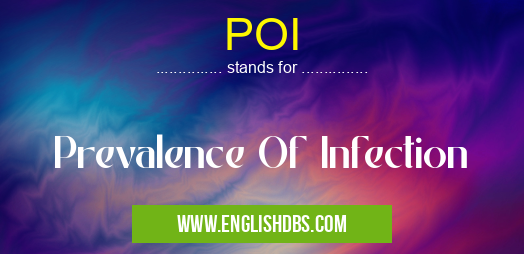What does POI mean in MEDICAL
POI stands for Prevalence Of Infection. It is a statistical measure that quantifies the proportion of individuals within a population who are infected with a particular pathogen or microorganism. POI plays a crucial role in understanding the epidemiology and spread of infectious diseases, aiding in the development of effective prevention and control strategies.

POI meaning in Medical in Medical
POI mostly used in an acronym Medical in Category Medical that means Prevalence Of Infection
Shorthand: POI,
Full Form: Prevalence Of Infection
For more information of "Prevalence Of Infection", see the section below.
POI Meaning in MEDICAL
In the medical context, POI refers to the prevalence of infection within a specific population or setting. It can be calculated by dividing the number of individuals who are infected with the pathogen by the total population size at a given point in time. POI provides insights into the extent to which an infection has spread and its potential impact on the community.
POI Full Form
The full form of POI is Prevalence Of Infection.
What does POI Stand for?
POI stands for Prevalence Of Infection.
Essential Questions and Answers on Prevalence Of Infection in "MEDICAL»MEDICAL"
What is Prevalence of Infection (POI)?
POI is a measure of the proportion of individuals in a population who have a specific infection at a given time. It represents the number of current cases within a population.
How is POI calculated?
POI is calculated by dividing the number of individuals with the infection by the total population size and multiplying by 100.
Why is POI important?
POI provides valuable information about the spread and impact of infectious diseases. It helps healthcare professionals understand the burden of infection in a population and plan appropriate interventions.
What are the factors that affect POI?
Factors that can influence POI include:
- Population size and density
- Age, gender, and ethnicity
- Socioeconomic status
- Healthcare access
- Vaccination rates
- Disease characteristics
How can POI be reduced?
Reducing POI involves implementing public health measures such as:
- Vaccination campaigns
- Infection control practices
- Improved sanitation and hygiene
- Education and awareness programs
- Surveillance and early detection
What are the limitations of POI?
Limitations of POI include:
- It represents a snapshot in time and may not reflect long-term trends.
- It does not provide information about the severity or duration of infections.
- It may be challenging to obtain accurate data, especially for asymptomatic infections.
Final Words: POI is an essential metric for assessing the burden of infectious diseases and guiding public health interventions. By monitoring and analyzing POI data, healthcare professionals and policymakers can identify areas with high infection rates, prioritize resources, and implement targeted measures to prevent and control the spread of infections. A comprehensive understanding of POI contributes to the improvement of public health outcomes and the promotion of a healthier population.
POI also stands for: |
|
| All stands for POI |
